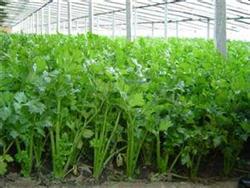Control of celery late blight in greenhouse

Celery late blight, also known as spot blight and leaf spot, is a common disease in celery. The late blight of celery planted in greenhouse is more serious than that of celery in open field, which has a great effect on the yield and quality of celery. Occurrence characteristics: celery late blight is a fungal disease, which can survive the winter on seeds and remnants. Sowing diseased seeds causes disease immediately after emergence, produces conidia, and spreads in the seedling bed. The source of overwintering bacteria on the diseased remains, under suitable conditions, produce conidia to spread by wind and rain, infect celery, and then produce conidia for repeated infection. The pathogen grows well under cold and wet conditions, and the optimum temperature for the disease is 18Mel 25 ℃, and the humidity is more than 95%. Celery in the greenhouse generally has a serious disease. In case of continuous rainy weather, frequent temperature fluctuations, or foggy dew, plant growth is weak, it is conducive to the rapid expansion and spread of the disease. The disease can continue to develop during the Tibetan period, and the loss is often more severe than in the field. Prevention and control methods. In order to prevent and control celery late blight, we should first strengthen fitness cultivation. In addition to selecting and sowing disease-free seeds and doing a good job of seed disinfection, we should also apply fully mature soil fertilizer in fertilizer and water management, prevent partial application of chemical nitrogen fertilizer, and implement rill irrigation. Do not irrigate too much water and water temperature, maintain loose ventilation of vegetables in vegetable fields, and properly spray plant growth hormone and foliar fertilizer to increase plant disease resistance. At the same time, we should do well the ventilation and moisture drainage of the greenhouse and the management of heat preservation at night, reduce the temperature difference between day and night, reduce plant dew, control bacterial infection, eliminate the residual leaves of diseased plants and reduce the source of bacteria in the field. When the disease is first seen in the field, it is necessary to pay close attention to spraying control. At present, the better agents for the prevention and control of celery late blight are: 75% chlorothalonil wettable powder 600 times, or 64% antiseptic alum M8 500 times wettability, or 40% polysulfide suspension 500 times, generally 50 million 75 kilograms per mu, one of the above chemicals is optional, sprayed every 7 times 10 times, 2 times 3 times.
- Prev

Technology of accelerating germination of celery seed in high temperature season
The optimum temperature for celery seed germination is 15-25 ℃, but it is difficult to germinate when it exceeds 30 ℃. Sowing celery in high temperature season can take the following methods to deal with seeds to promote neat germination. Soak the seeds in clean water for 24 hours after 1 day of variable temperature treatment, change the water every 8 hours, then remove, wash and wrap them with wet gauze and put in 5 ℃.
- Next

Water and Fertilizer Management of celery in greenhouse
First, when the buds top the soil at the seedling stage, gently water once, and the seedlings can come out in 1 or 2 days. Keep the soil moist in the future, based on the principle of frequent watering and less watering. When the seedling height is 10 cm, it can be fertilized with water for 1 and 2 times. Second, planting and squatting seedlings should be watered frequently and gently to keep the soil moist from planting to slow seedling.
Related
- Where is it suitable to grow horseradish in China? it is expected to see the middle altitude horseradish in Alishan.
- How to prevent tomato virus disease reasonably? (Control methods included)
- Many people like to plant towel gourd on the balcony. What are the main points of this method and management?
- What crops can chili peppers be mixed with?
- Fertilization techniques and matters needing attention in Tomato
- What are the grafting techniques for peach seedlings in spring?
- Harm and control methods of root swelling disease of Chinese cabbage
- What are the pests of sweet potatoes? How to prevent and cure it?
- Symptoms, causes and Control methods of navel Rot in Tomato
- The cause of "Cucumber rotten bibcock" in Farmers' planting Cucumber and its Control Plan

